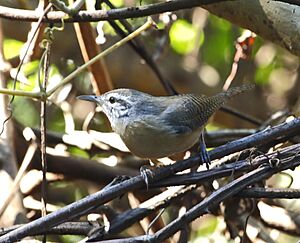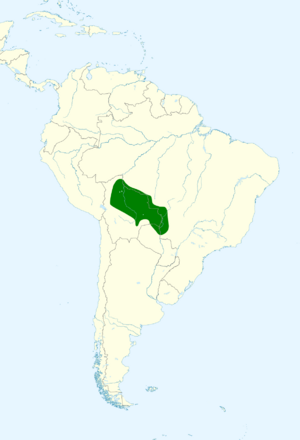Fawn-breasted wren facts for kids
Quick facts for kids Fawn-breasted wren |
|
|---|---|
 |
|
| Conservation status | |
| Scientific classification | |
| Genus: |
Cantorchilus
|
| Species: |
guarayanus
|
 |
|
| Synonyms | |
|
Thryothorus guarayanus |
|
The fawn-breasted wren (Cantorchilus guarayanus) is a small bird that belongs to the wren family, Troglodytidae. You can find this bird living in parts of Bolivia, Brazil, and Paraguay.
Contents
About the Fawn-breasted Wren
Scientists study how different animals are related to each other. The fawn-breasted wren was once thought to be the same species as the buff-breasted wren. However, these two birds sing very different songs! Because of their unique songs, scientists now consider the fawn-breasted wren a distinct species. It does not have any known subspecies.
What Does the Fawn-breasted Wren Look Like?
This small bird is about 13.5 cm (5.3 inches) long. It weighs about 13 to 14 grams (about half an ounce).
Adult fawn-breasted wrens have a plain, medium brown head and back. Their lower back and rump (the area above their tail) are a reddish-brown color. Their tail is reddish-brown with clear black stripes.
They have a thin white stripe above their eye, mostly behind it. Their cheeks look speckled with gray-white and blackish spots. They also have black stripes near their beak and chin. The chin is whitish, and their chest is a warm orange-buff color. Their belly is an even deeper orange-buff. Young wrens look similar to adults, but their face markings are not as clear.
Where Does the Fawn-breasted Wren Live?
The fawn-breasted wren lives in a large area of northeastern Bolivia. It also lives in a narrow strip of western Brazil, right next to Bolivia. A small part of northeastern Paraguay is also home to this bird.
These wrens prefer to live in scrublands and young forests that are growing back. They especially like areas near water. You can find them at elevations up to about 400 meters (1,300 feet) above sea level.
Fawn-breasted Wren Behavior
How the Fawn-breasted Wren Finds Food
Fawn-breasted wrens usually search for food in pairs during the dry season. After their young hatch, they forage in small family groups. They hunt for food in thick plants and bushes. They usually look for food from the ground up to about 4 meters (13 feet) high. Sometimes, they might go as high as 10 meters (33 feet) to find food. Scientists have not yet fully documented what these wrens eat.
Reproduction and Nests
Scientists have only found and described a few fawn-breasted wren nests. Not much is known about their breeding habits.
Their nests are like a flimsy dome made of grasses and root hairs. They have an entrance on the side. These wrens build their nests up to 3 meters (10 feet) above the ground. They place them in weeds, bushes, or at the bottom of small palm trees. A female fawn-breasted wren usually lays two eggs.
Fawn-breasted Wren Songs and Calls
When a pair of fawn-breasted wrens sings, they often sing back and forth to each other. This is called antiphonal singing. The male's song sounds like "cheerilo-choli." The female's part sounds like "pew-pew, pew-pew." Besides their songs, they also make calls that sound like a repeated "pew-pew" and harsh clicking noises.
Conservation Status
The IUCN (International Union for Conservation of Nature) has evaluated the fawn-breasted wren. They have assessed it as a species of "Least Concern." This means that the bird is not currently considered to be in danger of extinction. Even though its exact population size isn't known, scientists believe it is fairly common to common throughout the areas where it lives.


